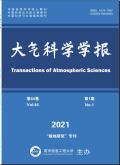大气科学学报2024,Vol.47Issue(4):570-580,11.DOI:10.13878/j.cnki.dqkxxb.20230518003
冬季南北半球际大气质量涛动与东亚冬季风异常联系的模式验证
Model verification of the relationship between inter-hemispheric atmos-pheric mass oscillation and East Asian winter monsoon
摘要
Abstract
The interaction between mid-high latitudes in the atmosphere of the Northern and Southern Hemi-spheres is closely related to cross-hemisphere weather and climate systems,such as monsoons.Due to the involve-ment of large-scale circulation and global energy changes,the correlation pathway and mechanism have garnered extensive attention from scholars.The inter-hemispheric air mass oscillation(IHO)index is defined as the differ-ence in atmospheric mass between the Northern and Southern Hemispheres,reflecting changes in global atmos-pheric circulation caused by the exchange of atmospheric mass between the hemispheres.Using ERA5 reanalysis data post-1979,the winter IHO showed a significant positive correlation with the East Asian winter monsoon a-nomaly(correlation coefficient r=0.49).The historical output data of the CMIP6 models further verified this re-lationship,showing a positive correlation in 96.7%of the models,with a correlation coefficient of 0.35 in the MPI-ESM1-2-HR model,statistically significant at the 95%confidence level.Using ERA5 reanalysis data and the historical experimental data of the MPI-ESM 1-2-HR model,we verified the influence of IHO anomalies on the in-terannual variation of the East Asian winter monsoon and the underlying physical processes.The results indicate that the IHO is closely related to the East Asian winter monsoon through the redistribution of global air mass.Dur-ing a positive IHO phase,atmospheric mass accumulates abnormally deposited in northern Eurasia and decreases in the middle and low latitudes,significantly increasing the sea-land pressure difference in East Asia and strength-ening winter winds,and vice versa.Additionally,the combined difference in surface pressure between high and low IHO years shows that the Antarctic air mass anomaly contributes most of the negative anomalies in the South-ern Hemisphere,indicating that the Antarctic air mass oscillation is the main driver of the North-South air mass oscillation.In the MPI-ESM1-2-HR model,the IHO significantly impacts winter surface air temperature in China,particularly in Central China,with a correlation coefficient of-0.29 between winter surface air temperature and the IHO index in Central China.Analysis of the MPI-ESM1-2-HR model reveals that the correlation coefficient between the IHO and the average temperature of the upper troposphere in the Antarctic region is-0.32(passing the 90%significance test),indicating that the temperature of the upper troposphere in the Antarctic region signifi-cantly drives the interannual variation of the IHO.Ozone is identified as the primary factor affecting temperature changes in the Antarctic region.The mean temperature of the upper troposphere and ozone content in the Antarctic region are significantly positively correlated(r=0.33,passing the 95%significance test),indicating that ozone changes play a dominant role in the temperature of the Antarctic troposphere.The temperature in the upper Antarc-tic troposphere is inversely correlated with that in the lower stratosphere of the equator(10°S-10°N)at 100-70 hPa,with a correlation coefficient of-0.38(passing the 95%significance test).This suggests that the temper-ature at the bottom of the tropical stratosphere influences the temperature of the Antarctic troposphere through re-sidual circulation,regulating the interannual oscillation of the Antarctic air mass and causing the imbalance be-tween the hemispheres.When the tropical stratosphere temperature rises,the ozone and temperature in the upper Antarctic troposphere decrease,leading to significant negative temperatures and geopotential anomalies over Ant-arctica.The decrease in air temperature over Antarctica reduces internal energy,increases the polar vortex,and contracts the atmospheric column,reducing total energy and atmospheric mass in the Antarctic region,thereby in-creasing the atmospheric mass difference between the hemispheres,and vice versa.关键词
东亚冬季风/南北半球际大气质量涛动/温度"跷跷板"/CMIP6Key words
East Asian winter monsoon/inter-hemispheric atmospheric mass oscillation/temperature"seesaw"/CMIP6引用本文复制引用
钟磊,卢楚翰,乔年,管兆勇,曾跃飞..冬季南北半球际大气质量涛动与东亚冬季风异常联系的模式验证[J].大气科学学报,2024,47(4):570-580,11.基金项目
国家自然科学基金资助项目(41975073) (41975073)
国家重点研究与发展计划项目(2019YFC1510201) (2019YFC1510201)
上海市科学技术委员会项目(20dz1200401) (20dz1200401)
无锡学院引进人才科研启动基金 ()

